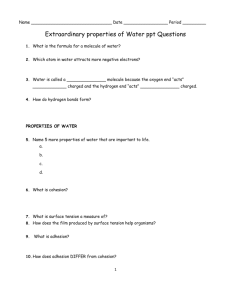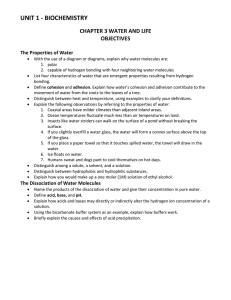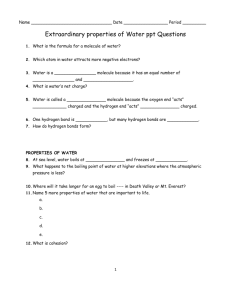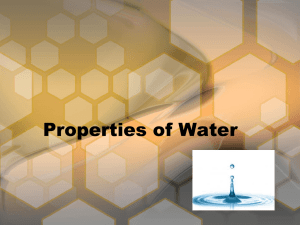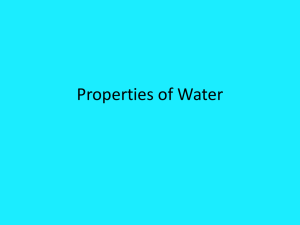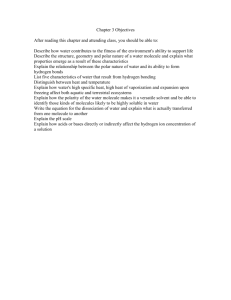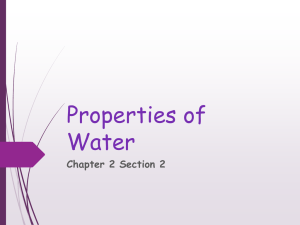The Extraordinary Properties of Water
advertisement
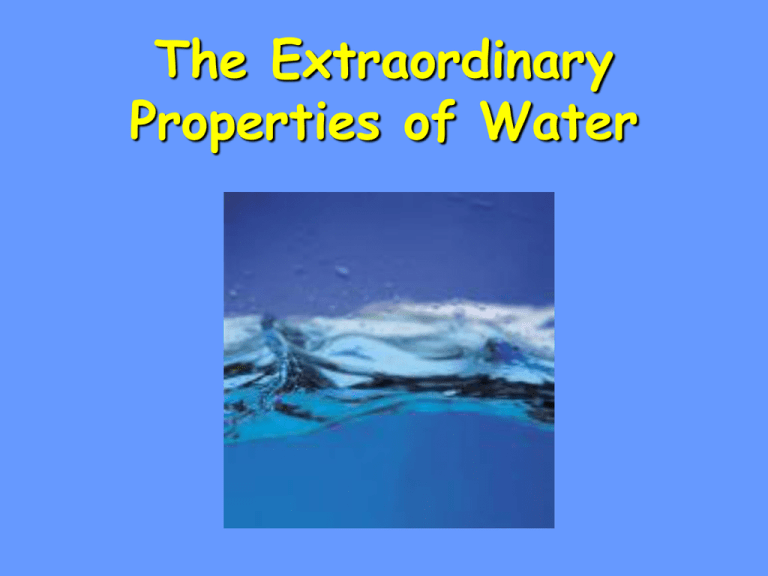
The Extraordinary Properties of Water Water • A water molecule (H2O), is made up of three atoms: one oxygen and two hydrogen. H H O The Water Molecule • Polarity – A water molecule is polar because there is an uneven distribution of electrons between the oxygen and hydrogen atoms. (-) (+) •Polar water molecules act like magnets and attract each other Hydrogen Bonds -form between the negative end of one water molecule and the positive end of another. -a hydrogen bond is weaker than an ionic or covalent bond BP and FP of Water •At sea level, pure water boils at 100 °C and freezes at 0°C. •212°F and 32°F Properties of Water • Cohesion Properties of Water • Cohesion • Adhesion Properties of Water • Cohesion • Adhesion • High Specific Heat Properties of Water • Cohesion • Adhesion • High Specific Heat • High Heat of Vaporization 1. Cohesion •Attraction between particles of the same substance - Explains why water is attracted to itself Results in: Surface tension (a measure of the strength of water’s surface) allows insects to walk on the surface of water Jesus Lizard • The Basilisk lizard makes use of the high surface tension of water to accomplish the incredible feat of walking on water's surface. The Basilisk can't actually walk on water; rather, it runs on water, moving its feet before they break through the surface. Take a look: • The 'Jesus' Lizard (473k movie) • http://www.visionlearning.com/library/module_vie wer.php?mid=57 2. Adhesion •Attraction between two different substances. - water forms hydrogen bonds with other surfaces such as glass, soil, plant tissues, and cotton. . • Explains capillary actionwater molecules will pull each other along when in a thin glass tube. • i.e. moves water up the tubes of plants from roots to leaves 3. High Specific Heat Amount of heat needed to raise or lower 1g of a substance 1° C. •Water can absorb or release a lot of heat energy with little change in temperature. As a result, water warms slowly and cools slowly. So, the oceans store heat. And, the body (mostly water) does not lose heat easily. 4. High Heat of Vaporization For water to evaporate, hydrogen bonds must be broken. As water evaporates, it removes a lot of heat with it. The “extra” energy needed to break hydrogen bonds means that evaporating water cools surfaces. Explains why sweating is a great way to stay cool. 5. Water is Less Dense as a Solid •Ice is less dense than liquid water (ice floats). •In winter, ice floats on lakes. Explains why fish can live in a lake in the winter; the lake freezes from the top down. Water as a Solvent • The partial charges on water molecules help make it an excellent solvent. • Water dissolves many substances by surrounding charged particles and "pulling" them into solution. For example, common table salt, sodium chloride, is an ionic substance that contains alternating sodium and chlorine ions. When table salt is added to water, the partial charges on the water molecule are attracted to the Na+ and Clions. The water molecules surround the ions, separate them, and slowly dissolve the salt. Negative oxygen ends of water molecules will surround the positive sodium ions. Positive hydrogen ends will surround the negative chlorine ions.
